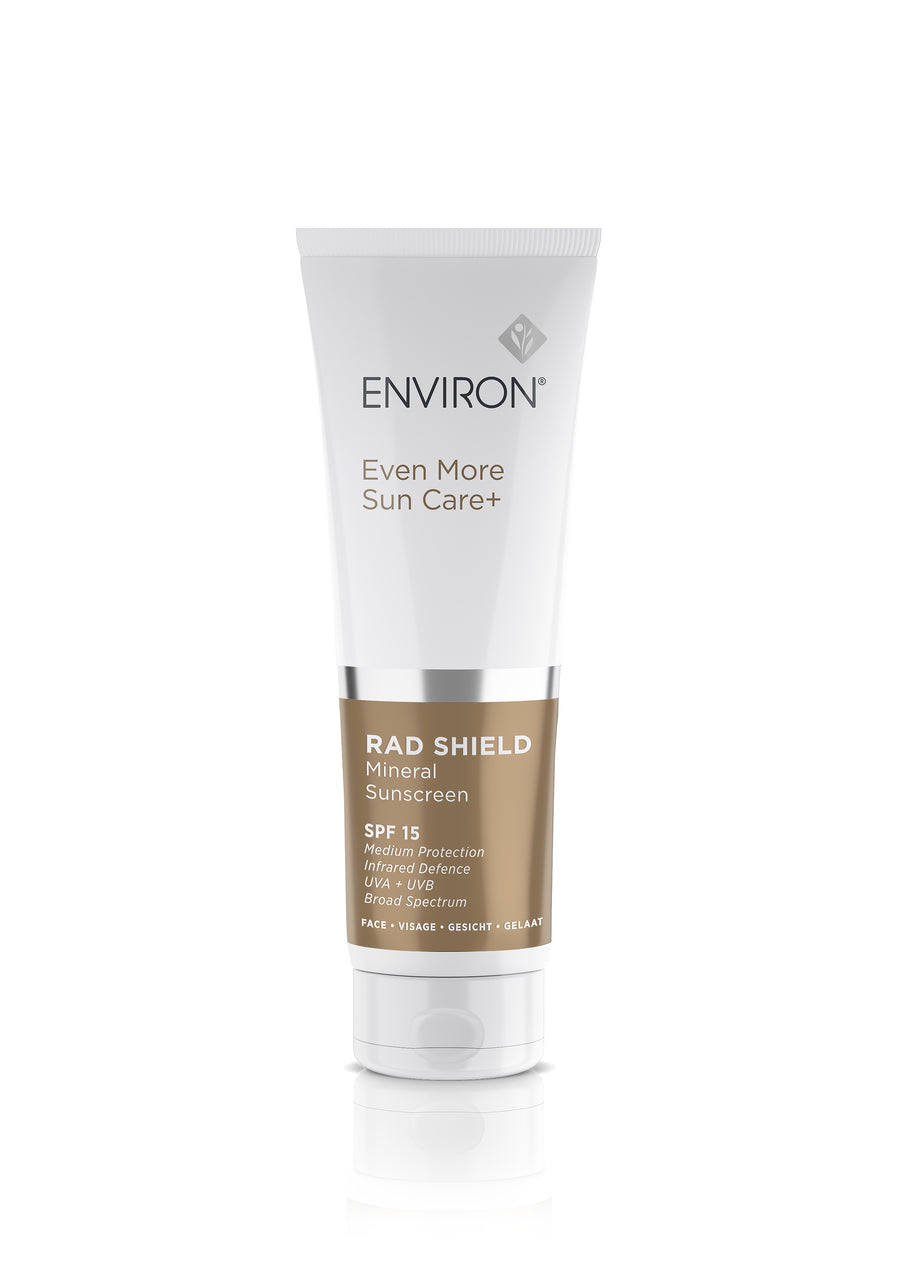Environ RAD Shield Mineral Sunscreen
New from Environ !!
Powerful physical sun reflectors:
new generation Zinc Oxide & Titanium Dioxide
Heat adaptive ingredient for infrared defence :
Venuceane ®
Powerful free radical defence :
Potent antioxidants
Beautiful, effective daily sun protection with
no white residual appearance
KEY INGREDIENTS
Titanium Dioxide Inorganic UVA & UVB Filter
Zinc Oxide Transparent inorganic UVA protection
Thermus Thermophillus Ferment ( Venuceane ™) Adaptive IR Protection
Butyrospermum Parkii (Shea) Butter Moisturiser
Tocopherol (Vitamin E)
Moisturiser & Antioxidant
Solanum Lycopersicum (Tomato) Fruit Extract Colourless carotenoids &
absorbs UV light
WHO SHOULD USE IT?
The products are suitable for everyone over 6 months of age, for use on skin of all
ages and for all skin types and conditions.
RAD SHIELD® Mineral Sunscreen may be preferred by consumers who prefer a
product with a moisturising, creamy texture.
HOW LONG DOES IT LAST?
Shelf life: Twenty four (24) months unopened. Should be used within 10 12 weeks of opening
Ideal post treatment or procedure sun protection
Chemical phobes
Oilier skin types who prefer light weight, non greasy
sunscreen
Sensitive skin conditions
Clients with active , sports lifestyles
Safe and suitable for delicate skin of children
WHO IS RAD SHIELD® FOR?
Do we really know how to protect our skin?
SPFs have never been higher, but neither has the rate of skin cancer. According to Cancer Research UK, over 15,400 people develop malignant melanoma each year, compared with around 1,800 in the mid-1970s. SPFs are now available in excess of 60, so why aren’t they protecting us?
Sunscreen products – saviours or sinners?
Despite using very high SPFs, the numbering system can be misleading. It’s logical to assume that SPF30 provides twice the protection of SPF 15, but it only blocks 4% more rays (SPF 15 blocks 93%) and contains a much greater level of potentially harmful chemicals. High SPFs give a false sense of security, which means people reapply them less frequently and spend longer in the sun. Another contributing factor to the rise of skin cancer is that people don’t apply enough, particularly if the SPF is high. The advice is to cover the skin in a ‘shot and a half’ but in a study published by the journal JAMA Dermatology, only 55% correctly identified the amount required.
Free radical damage
Research has shown that high SPFs can be harmful when left on the skin*.Chemical sunscreens are only effective for two-three hours after application. They absorb UV rays during this time, but once they stop working they turn into free radicals which react with DNA cells, increasing the visible signs of ageing and the risk of skin cancer. It’s therefore important to keep reapplying regularly.
“Scientists do not recommend anything stronger than SPF 15-20 because there is minimal advantage from the higher SPFs….stronger creams contain greater concentrations of sunscreen agents which themselves can be converted into free radicals by exposure to UV rays” says Dr Des Fernandes. It’s important to remember that SPF only indicates protection from UVB rays, which cause burning, and not UVA which cause photo-ageing so using a broad spectrum cream which protects against both is key.
A second line of defence
If your clients want to achieve superior protection against the sun, antioxidants need to be incorporated into their skincare regime. They mop up free radicals generated in the skin from UV exposure, minimising the damaging effects they have on DNA. Advise clients to apply an antioxidant sunscreen such as RAD from Environ®, and to also take them in supplement form to protect skin over the whole body (Skin Antioxidant from Advanced Nutrition ProgrammeTM contains a broad spectrum of antioxidants that have proven benefits with regards to UV radiation). Daily use is essential. Studies indicate that even on cloudy days 80% of radiation from UVA rays breaks through.
Powerful protection boost
Given its impeccable skin nourishing credentials, it’s no surprise that vitamin A helps defend against UV damage. “The most powerful sun-protective molecule is the retinyl palmitate form of vitamin A, which in adequate doses, can have a photo-protective effect of SPF20 and gives additional protection against UVA”, says Dr Fernandes. As well as applying topically, it should be taken in supplement form. “
By using a combination of Vitamin A and antioxidants, it’s possible to safely expose skin to the sun for no longer than 20 minutes without sunscreen, in order to synthesize vitamin D, which is vital for healthy skin as well as preventing conditions such as osteoporosis and even cancer.
SAFE IN THE SUNSHINE – A, B, C
A: Antioxidants are an essential sunscreen ingredient
B: Be vigilant – reapply regularly
C: Choose to include a daily dose of a vitamin A and antioxidant supplement




